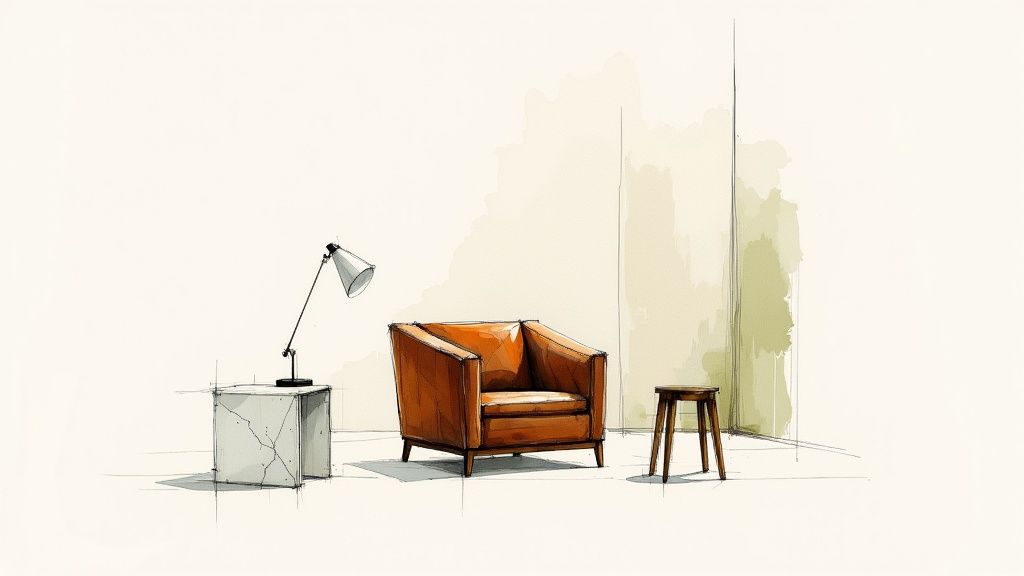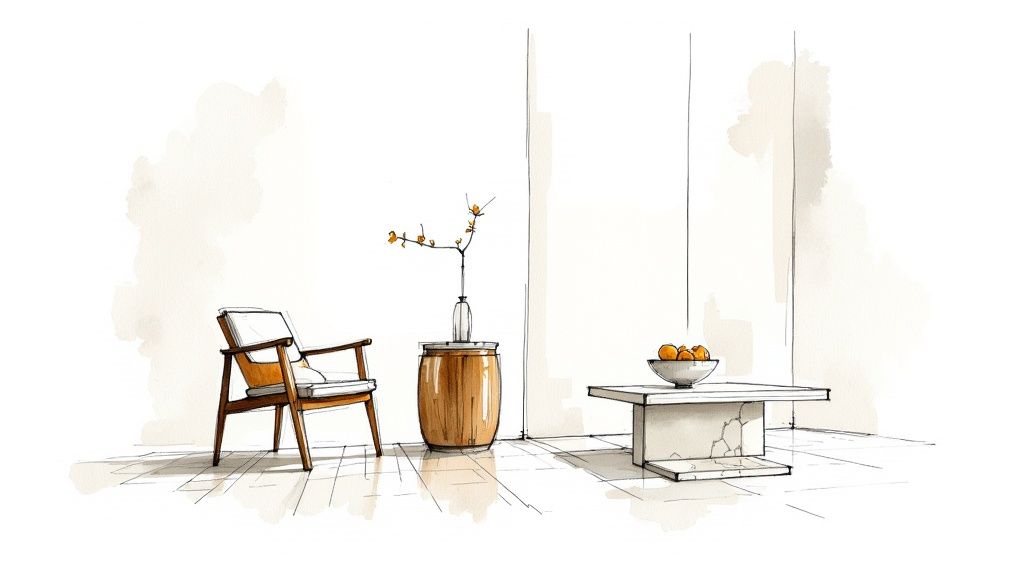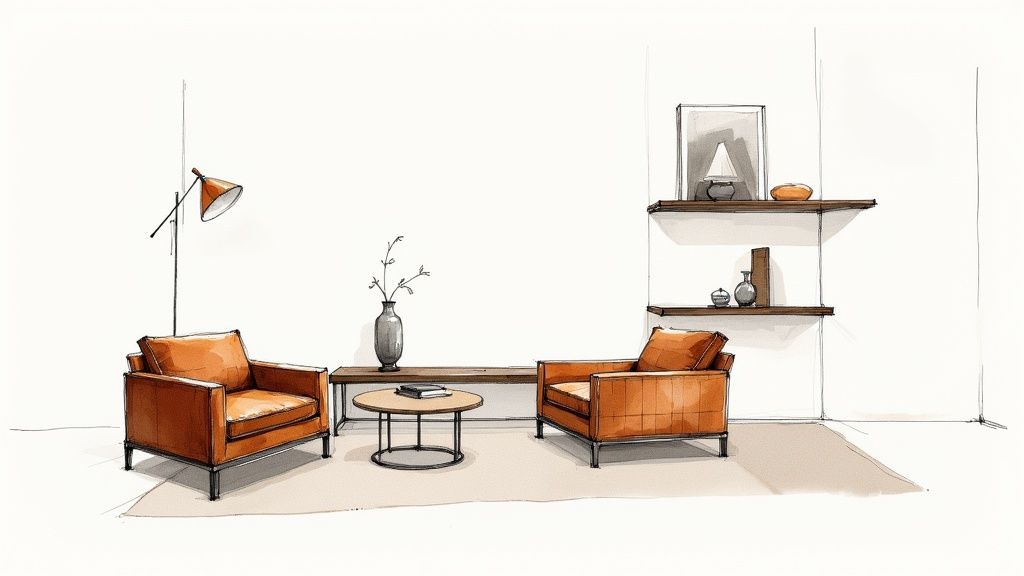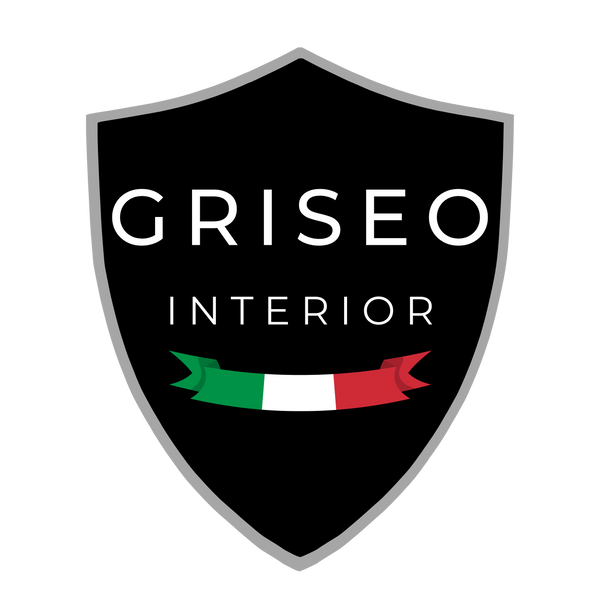
A Practical Guide to Made in Italy Design
Picture a room that feels both sophisticated and welcoming—a space that whispers elegance. That's the essence of Made in Italy design. More than a tag, it’s a practical philosophy for creating a home with soul. This guide will give you actionable steps to bring this timeless style into your life, focusing on quality, craftsmanship, and a vision that marries beauty with function.
How to Identify Authentic Italian Craftsmanship
At its heart, "Made in Italy" is a promise of quality. To bring it home, you first need to know what you're looking for. Think of it as learning to spot the difference between a fleeting trend and a future heirloom. It starts with understanding the blend of heritage and modern vision. Look for pieces that honor traditional techniques—like hand-stitched leather or expertly joined wood—but present them in clean, contemporary forms. This balance is the first clue you've found something special.
This philosophy is a cultural dedication to doing things right. To identify it, pay close attention to the details. Artisans pass down skills for generations, meaning every stitch, joint, and finish is handled with meticulous care. When you're shopping, don't just look; touch. Feel the weight of the material and the smoothness of the finish. The result shouldn't feel like a mass-produced product; it should feel like a piece of cultural identity, built to be loved for a lifetime.
More Than Just a Label: A Checklist for Buyers
So, what tangible signs separate a simple product from a true piece of Italian design? Use this checklist to guide your search and train your eye.
- Check the Materials: Start by identifying the core components. Authentic pieces celebrate nature's finest. Look for the distinct veining of Carrara marble, the deep grain of solid woods, or the supple, natural texture of genuine leather.
- Examine the Handiwork: Look for the "human touch." Are the stitches perfectly even? Are the joints seamless? This is evidence of traditional methods that machines can't replicate. It's the unique character in each piece.
- Assess the Design's Vision: Does the piece feel both timeless and fresh? Italian designers are masters at blending classic forms with contemporary ideas. A truly great piece should feel relevant today and for decades to come.
Actionable Tip: When you find a piece you love, ask about its story. Authentic makers are proud of their heritage. Learning about the workshop, the designer, and the materials connects you to the item and validates its quality.
This practical approach ensures you're not just furnishing a room; you’re investing in a legacy. To understand more about what makes these pieces so extraordinary, you can explore the essence of authentic Made in Italy design.
The Evolution of Italian Design
To truly appreciate "Made in Italy" design, it helps to understand its story. This isn't just a history lesson; it's a look at the creative problem-solving that defines Italian style. The post-World War II era was a crucible of creativity, where necessity sparked a design revolution.
Out of the devastation, a new energy emerged. Factories pivoted from war production to crafting for the home, creating a powerful partnership between architects and entrepreneurs. This was the moment everyday objects were elevated into art. Icons like Gio Ponti showed the world that function and breathtaking elegance could be one and the same, providing a blueprint for modern living that is still relevant today.
The Post-War Renaissance
The 1950s and 60s were Italy's "economic miracle," and design was at its heart. This era was defined by fearless experimentation with new materials and shapes. Designers weren't just making furniture; they were sculpting a new lifestyle that celebrated intelligence, simplicity, and grace.
Think of it as the ultimate creative challenge: rebuilding a nation with beauty and ingenuity. The result was a wave of iconic pieces that still feel startlingly modern, cementing Italy's role as a global design leader.
The Rise of Radical Design
Just as the world settled into this new modernism, another movement arrived to shake things up. The late 60s and 70s saw the birth of Radical Design, a rebellious movement that challenged the very definition of "good taste." Groups like Archizoom and Superstudio used design as a platform for social commentary, not just aesthetics.
They weren't just creating chairs and lamps; they were crafting manifestos. Radical Design proved that Italian design could be both beautiful and thought-provoking, a lesson in pushing boundaries that continues to inspire.
This willingness to tear up the rulebook is what keeps Italian design so vital. When you look at the history, a few key takeaways emerge that you can apply today:
- Constraints Fuel Creativity: The post-war era proved that limitations can ignite innovation.
- Collaboration is Key: The bond between visionary designers and skilled manufacturers remains the engine of Italian excellence.
- Always Evolve: From clean modernism to provocative anti-design, the best design never stops pushing forward.
This DNA is embedded in every authentic piece of "Made in Italy" design. When you understand the story, you see more than just a beautiful object—you see a legacy of passion, courage, and relentless creativity.
Core Principles Of Italian Design Excellence
So, what gives made in italy design its unmistakable character? It’s a practical philosophy built on three actionable pillars. Understanding them will help you choose pieces that feel authentic and timeless.
Prioritize Superior Materials
The first step is to look for pieces that honor their materials. Italian artisans choose each element for its innate beauty—from the cool veins of Carrara marble to the warm depth of solid walnut.
- Actionable Tip: When choosing a piece, ask yourself if the material is the star. The design should showcase, not hide, the natural texture and quality of the wood, stone, or leather.
This honesty in selection lets the material’s own story shine through.
Demand Masterful Craftsmanship
Next, inspect the construction. True Italian design celebrates making things by hand. Workshops pass down techniques through generations, ensuring every joint and stitch receives patient care. By the same token, the sector’s scope is staggering: it employs nearly 70,000 workers, accounts for about 20% of Europe’s specialized design workforce, and turns over €6.3 billion. These figures highlight how craftsmanship has become national identity. For a deeper dive, check the economic impact study at the Intesa Sanpaolo website.

The infographic traces a journey from post-war rebuilding to the Radical Design wave—each era building on that hands-on heritage.
Embrace La Bella Figura: Beauty in Function
Finally, apply the principle of La Bella Figura. This is the idea that an object is only truly elegant when its form and function are in perfect sync. A chair should not only look beautiful but also provide perfect comfort.
Actionable Tip: Before buying, always test the function. Sit in the chair. Open the cabinet doors. A piece that looks good but feels awkward or impractical fails the test of La Bella Figura.
Let’s translate these principles into a practical reference.
Core Tenets of Made in Italy Design
Use this table as a quick guide when evaluating potential pieces for your home.
| Principle | Actionable Test | Real-World Example |
|---|---|---|
| Material Reverence | Does the design highlight the material's natural beauty? | A Carrara marble coffee table with a simple, clean base. |
| Masterful Craftsmanship | Are the joints, stitches, and finishes flawless upon close inspection? | Hand-stitched cabinetry where the wood grain aligns perfectly. |
| Functional Beauty | Is the piece as comfortable and useful as it is beautiful? | A sculptural armchair from Griseo Interior that offers ergonomic support. |
This framework—material reverence, artisanal mastery, and functional beauty—is your roadmap to identifying and incorporating authentic made in italy design into your home.
Italian Furniture and Textiles Spotlight

To apply the principles of Made in Italy design, focus on two key areas: furniture and textiles. These are where the balance of beauty and everyday function comes to life, shaping the soul of a modern home.
Italian furniture is a masterclass in harmony, where seasoned craftsmanship meets modern efficiency. This partnership results in pieces that feel both timeless and perfectly suited to contemporary life.
How to Select Heirloom Furniture
The core philosophy is simple: choose pieces designed to be cherished for a lifetime. This isn't about chasing trends; it's about investing in the heirlooms of tomorrow. Here’s how to do it:
- Prioritize a Sustainable Soul: Look for makers who choose materials for their endurance and environmental integrity. A responsibly sourced solid wood table is a lasting investment in your home and the planet.
- Look for Technological Grace: Seek out innovation that enhances, rather than replaces, craftsmanship. This could be smart features seamlessly integrated into a classic design or advanced joinery that strengthens both form and function.
The goal is furniture that feels alive with history and purpose. To see these principles in action, take a look at our guide to finding the perfect Italian coffee tables for your living space.
This is how a simple table or chair becomes something more. It transforms into a centerpiece of family life, a silent witness to shared memories, and a beautiful object passed from one generation to the next.
Choosing the Right Textiles
Equally important are Italian textiles—the final layer that brings quality and creativity to a room. This industry is a testament to the magic of specialized, small-scale production.
The Italian textile and fashion industry is a cornerstone of the nation’s identity. With a market size hitting around US$25.67 billion in 2024 and still growing, its strength lies in a dense network of 45,000 companies. What's truly remarkable is that 82% of these are small, family-run workshops with fewer than 10 employees, preserving an incredible depth of skill and local expertise.
Actionable Tip: When selecting fabrics, focus on texture. Run your hand over velvets, linens, and wools. Italian fabrics are celebrated for rich textures, bold patterns, and sophisticated color palettes. Choose textiles that not only look good but also feel incredible to the touch.
How to Bring Italian Design Into Your Home

So, how do you translate the soul of Made in Italy design into your own space? The secret is that it doesn't require a total overhaul. True Italian style is born from intention, not excess. The most effective method is to start with a single, powerful piece that anchors the room.
Think of this as your "hero" piece. It could be a sculptural floor lamp, a masterfully crafted leather armchair, or a marble coffee table that doubles as art. This one object becomes the heart of the room, and all other elements should support it. By starting here, you create an instant focal point and give your space a clear, confident voice.
Build Around a Neutral Palette
With your hero piece in place, the next step is to make it shine. The best way to do this is with a quiet, neutral color palette. The magic of Italian design lies in the raw beauty of its materials; a calm background gives them the spotlight.
Paint walls in soft whites, gentle grays, or earthy beiges to create a serene canvas. This isn't about creating a boring room. It's about shifting the focus to texture and form. The rich grain of a wooden console or the subtle sheen of a silk pillow becomes the main event, adding layers of depth and sophistication.
This dedication to functional, high-quality design is exactly why the Italian furniture industry remains a global powerhouse. In fact, the sector is projected to grow at a CAGR of 4.8% between 2025 and 2033. Luxury and smart furniture are expected to be the main drivers, accounting for 60% of total revenue and showing just how much the world craves modern, sustainable Italian craftsmanship.
Master Light and Space
The final, transformative layer is light and space. Mastering these is crucial for capturing the clean, atmospheric feel of an Italian home. The strategy is simple: use strategic lighting and embrace intentional simplicity.
Actionable Tip: Remember that what you leave out is as important as what you put in. Treat open space as a luxury. It allows each object to breathe and be appreciated for its form and function.
Ready to bring it all together? Here are three practical steps:
- Layer Your Lighting: Don’t rely on a single overhead light. Combine ambient (a central fixture), task (a reading lamp), and accent (spotlights on art) lighting to create mood and functionality.
- Embrace Decluttering: Live by the "one in, one out" rule. For every new piece you bring home, let something else go. This simple habit preserves the balance and honors the clean lines of your design.
- Choose Intentional Decor: Resist filling every surface. Instead, select a few meaningful objects, like a minimalist Griseo Interior vase or a single, striking sculpture.
By starting with one great piece and focusing on quality over quantity, you can cultivate a home that feels both serene and unmistakably Italian. For more inspiration, explore our guide on weaving modern Italian home decor into your life.
The Enduring Legacy of Italian Craftsmanship
In a world filled with fleeting trends, Made in Italy design is an anchor. It’s a practical statement of permanence and a quiet rebellion against the disposable.
When you choose an authentic Italian piece, you're not just buying an object. You are making a strategic investment in enduring quality and a more intentional way of life. It’s about embracing the philosophy of vivere bene—the art of living well.
This is a commitment to surrounding yourself with things that are not only beautiful but are built with such care that they are meant to last, gathering stories as they go. Every piece, whether it's a minimalist vase from Griseo Interior or a hand-stitched leather armchair, carries the soul of its maker. It’s an invitation to slow down and appreciate the human touch and artistry that turn a house into a home.
Choosing Italian design is choosing a legacy. It's about selecting pieces that resonate with your personal story, bringing lasting joy and a quiet, confident elegance into your daily life for generations to come.
We hope this guide has given you the confidence and practical tools to explore this incredible world for yourself, helping you find designs that tell a story that is uniquely yours.
A Few Questions We Hear Often About Italian Design
Diving into the world of Made in Italy design is exciting, but it often brings up a few questions. Getting clear answers helps you choose pieces with confidence. Here are some of the most common queries.
What’s the Real Difference Between “Made in Italy” and Other Luxury Design?
The tangible difference lies in a unique blend of three elements: a deep respect for artisanal history, an obsession with the best materials, and a culture of continuous design innovation. It’s not just about where a piece is assembled. It’s about being born from a cultural ecosystem that has celebrated beauty and functionality for centuries. This gives Italian design a soul and a story that you won't find in mass-produced luxury.
How Can I Spot a Genuinely Authentic Made in Italy Piece?
Authenticity is in the details. The best method is to become a hands-on detective. Use this three-step check:
- Look closely at the craftsmanship. Examine the stitching on leather, the joinery on wood. Are they seamless and perfect? These are the signatures of a master craftsperson.
- Feel the materials. Real quality has weight and texture. Learn the difference between the feel of a solid oak table versus a veneer, or full-grain leather versus a bonded composite.
- Know the maker's story. Reputable Italian brands are proud of their history. A quick search should reveal a rich legacy and a clear commitment to their craft. If the story is missing, be skeptical.
Actionable Tip: A true Italian piece is an investment. The price reflects hours of skilled labor, superior materials, and brilliant design. Trust your hands and your eyes—you can often feel the quality before you see the price tag.
Is Italian Design Only for Super Modern or Minimalist Homes?
Absolutely not. This is a common misconception. While Italy is famous for modernism, the core principles—quality materials and timeless shapes—are incredibly versatile. These pieces can feel right at home in almost any interior, from traditional to eclectic. A classic Italian leather sofa can ground a traditional living room, while a Murano glass chandelier can be a show-stopping centerpiece in an ornate dining room. It's about choosing pieces with timeless forms that elevate any space they inhabit.
At Griseo Interior, we live and breathe this spirit, bringing together timeless Italian craftsmanship and a modern, sustainable vision. You can see it in every one of our minimalist vases, furniture pieces, and decor items.
Start exploring our collection at https://griseointerior.com.
